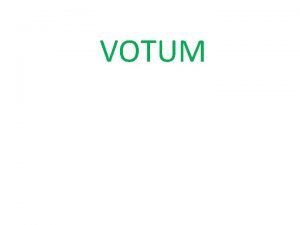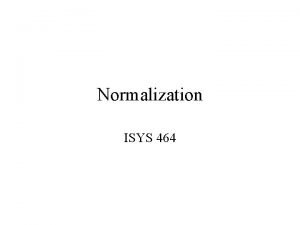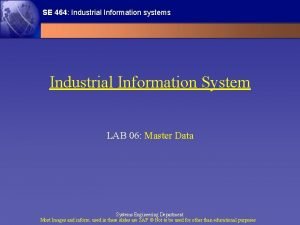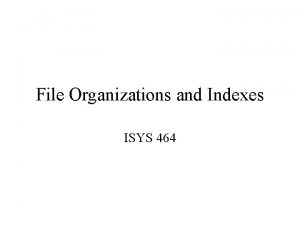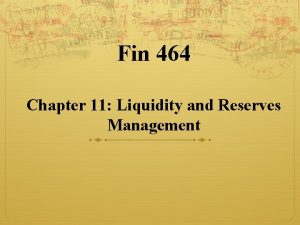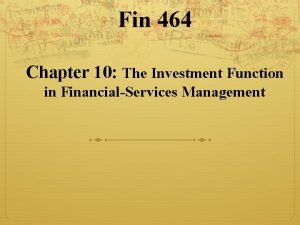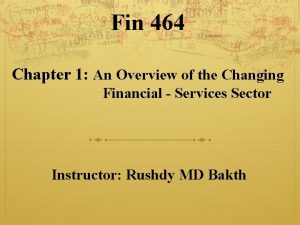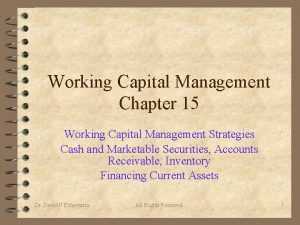Fin 464 Chapter 15 The Management of Capital

















- Slides: 17

Fin 464 Chapter 15: The Management of Capital

15 -2 Introduction • What is capital? ▫ Funds contributed by the owners of a financial institution ▫ The long-term funds coming from debt & equity that support a bank’s long-term assets & absorb its earnings losses. • Raising and retaining sufficient capital to protect the interests of customers, employees, owners, and the general public is tough • Why is capital so important in financial-services management? ▫ It provides a cushion of protection against risk and promotes public confidence • Capital has become the centerpiece of supervision and regulation today

15 -3 The Many Tasks Capital Performs 1. Provides a cushion against the risk of failure 2. Provides funds to help institutions get started 3. Promotes public confidence 4. Provides funds for growth, i. e. new services & facilities 5. Regulator of growth, i. e. it must rise with the growth of risky assets 6. Regulatory tool to limit risk exposure

15 -4 Key Risks in Banking Management Credit Risk: When borrowing customers failed in payments, defaulted loans & securities result losses than erode capital. Liquidity Risk: Danger of running out of cash during the time of deposit withdrawal and to meet good credit requests. Interest Rate Risk: Danger that revenues from earning assets will decline or that interest expenses will rise, squeezing the margin. Operational Risk: Risk due to weather damage, old technology, breakdowns in quality control, inefficiencies in services, error in judgment by management , fluctuations in the economy, etc. Exchange Risk: Risk face from dealings in foreign currency where the institution run the risk of adverse price movements on both the buying & selling sides of this market. Crime Risk: The danger that a bank will lose funds as a result of robbery or other crimes committed by its customers or employees

15 -5 Banks Defense against Risk 1. Quality Management: Ability of the top-notch management to react swiftly with the problems. 2. Diversification: Diversification of sources and uses of funds has risk-reducing benefits. ▫ Geographic Diversification: customers located in different communities or countries to experience different economic condition. ▫ Portfolio Diversification: wide variety of customers, large or small business accounts, different industries, households with variety of sources of income & collateral. 3. Deposit Insurance: Protect deposit up to a certain amount by FDIC or any insured depository institution which are examining the bank and taking actions against the bank’s mismanagement. 4. Owners’ Capital: When all fails, it is owners’ capital (net worth) that forms the ultimate defense against risk. It absorbs losses from bad loans, poor securities investments, crime, and misjudgment to recover the losses.

15 -6 Types of Bank Capital 1. Common stock: measured by the par value of common equity shares outstanding 2. Preferred stock: measured by the par value of shares outstanding that promise to 3. 4. 5. 6. pay fixed rate of return (dividend rate) Surplus: representing the excess amount above each share of stock’s par value paid by the shareholders. Undivided profits: net earnings that have been retained in the business rather than being paid out as dividends Equity reserves: funds set aside for contingencies such as legal action against the institution or dividends expected to be paid but not yet declared, and sinking fund to retire stock/bond in future. Subordinated debentures/junior debt: debt instruments/loans that ranks below other loans (or securities) with regard to claims on assets or earnings. In the case of default, creditors with subordinated debt wouldn't get paid out until after the senior debt holders were paid in full. Therefore, subordinated debt is more risky. 7. Minority interest in consolidated subsidiaries: where the financial firm holds ownership shares in other business. 8. Equity commitment notes: debt securities repayable from the sale of stock. A type of mandatory convertible bond issued by a bank or other lending institution that qualifies as regulated capital.

15 -7 How Much Capital Is Really Needed? □ How much capital a financial firm should hold has been the evolved around two questions: • Who should set capital standards, market or regulatory agencies? • What is a reasonable standard for the proper amount of capital? ▫ Reasons for Capital Regulation ─ Bank must meet minimum capital requirement before they can be chartered, and they must hold at least the minimum required level of capital throughout their corporate life 1. To limit risk of failures 2. To preserve public confidence 3. To limit losses to the government and other institutions arising from deposit insurance claims ▫ Research Evidence ─ Research has been conducted on the issue of whether the private marketplace or government regulatory agencies exert a bigger effect on bank risk taking ─ Most studies find that the private marketplace is probably more important than government regulation in the long run in determining the amount & type of capitals bank holds.

15 -8 The Basel Agreement An international treaty involving the U. S. , Canada, Japan & the nations of Western Europe to impose common capital requirements on all banks in those countries. ▫ Designed to keep their capital positions strong ▫ Reduce inequalities in capital requirements among different countries ▫ Promote fair competition ▫ Catch up with recent changes in financial services and financial innovation ▫ In particular, the expansion of off-balance-sheet commitments ▫ Formally approved in July 1988 ▫ Included countries such as: ▫ The United States, Belgium, Canada, France, Germany, Italy, Japan, the Netherlands, Spain, Sweden, Switzerland, the United Kingdom, and Luxembourg

15 -9 The Basel Agreement ü Basel I : The original Basel capital standards are known today as Basel I ü Various sources of capital were divided into two tiers: ▫ Tier 1 (core/primary) capital Common stock and surplus, undivided profits (retained earnings), qualifying noncumulative perpetual preferred stock, minority interest in the equity accounts of consolidated subsidiaries, and selected identifiable intangible assets less goodwill and other intangible assets ▫ Tier 2 (supplemental) capital Allowance (reserves) for loan and lease losses, subordinated debt capital instruments, mandatory convertible debt, intermediate-term preferred stock, cumulative perpetual preferred stock with unpaid dividends, and equity notes and other long-term capital instruments that combine both debt and equity features ü In order for a bank to qualify as adequately capitalized, it must have: 1. A ratio of core capital (Tier 1) to total risk-weighted assets of at least 4 % 2. A ratio of total capital (the sum of Tier 1 and Tier 2 capital) to total riskweighted assets of at least 8 %, with the amount of Tier 2 capital limited to 100 percent of Tier 1 capital.

15 -10 Calculating Risk-Weighted Assets ▫ Each asset item on a bank’s balance sheet and each off-balance-sheet commitment it has made are multiplied by a risk-weighting factor ▫ Designed to reflect its credit risk exposure ▫ The most closely watched off-balance-sheet items are standby letters of credit and long-term, legally binding credit commitments ▫ Under Basel I, once we know a bank’s total risk-weighted assets and its Tier 1 and Tier 2 capital amounts, we can determine its required capital adequacy ratios

15 -11 Basel 1 • Bank Capital Standards and Market Risk ▫ Basel I failed to account for market risk ▫ The losses a bank may suffer due to adverse changes in interest rates, security prices, and currency and commodity prices ▫ The risk weights on bank assets were designed primarily to take account of credit risk (not market risk) ▫ In an effort to deal with these and other forms of market risk, in 1996 the Basel Committee approved a modification to the rules ▫ Permitted the largest banks to conduct risk measurement and estimate the amount of capital necessary to cover market risk ▫ Led to a third capital ratio (Tier 3)

15 -12 Basel II ▫ Bankers found ways around many of Basel I’s restrictions ▫ Instead of making banks less risky, parts of Basel I seemed to encourage banks to become more risky ▫ Basel I represented a “one size fits all” approach to capital regulation ▫ It failed to recognize that no two banks are alike in terms of their risk profiles ▫ Basel II set up a system in which capital requirements would be more sensitive to risk and protect against more types of risk than Basel I ▫ Low risk assets would require less capital than high risk assets ▫ Under Basel I, minimum capital requirements remained the same for most types of loans regardless of credit rating ▫ Under Basel II, minimum capital requirements were designed to vary significantly with credit quality

Basel Accord Summary Credit risk was divided into 5 categories: 0%, 10%, 20%, 50%, and 100% Commercial loans, for example, were assigned to the 100% risk weight category 50% weight attributed to mortgage loans To calculate required capital, a bank would multiply the assets in each risk category by the category’s risk weight and then multiply the result by 8% ● ● Thus a $100 commercial loan would be multiplied by 100% and then by 8%, resulting in a capital requirement of $8 Basel-I accord was criticized i) for taking a too simplistic approach to setting credit risk weights and ii) for ignoring other types of risk Banks developed techniques to avoid compliance with the capital requirements known as Capital Arbitrage. □ If a bank were managing and holding mortgages on houses, it would have to maintain a capital requirement of 4%. Instead, it sells the mortgages and uses the proceeds to buy US government bonds, then under the rules, US government bonds produce no capital requirement and the bank would thus have no capital maintenance. Securitization is the main means used especially by U. S. banks to engage in regulatory capital arbitrage as it involves reducing the measures of risk.

Basel Accord Summary (cont) Assume a bank has a portfolio of commercial loans with the following ratings and internally generated capital requirements AA-A: 3%-4% capital needed B+-B: 8% capital needed B- and below: 12%-16% capital needed Under Basel-I, the bank has to hold 8% risk-based capital against all of these loans To ensure the profitability of the better quality loans, the bank engages in capital arbitrage--it securitizes the loans so that they are reclassified into a lower regulatory risk category with a lower capital charge Lower quality loans with higher internal capital charges are kept on the bank’s books because they require less risk-based capital than the bank’s internal model indicates By the late 1990 s, growth in the use of regulatory capital arbitrage led the Basel Committee to begin work on a new capital regime (Basel-II) ▫ Effort focused on using banks’ internal rating models and internal risk models ▫ Under Basel I, minimum capital requirements remained the same for most types of loans regardless of credit rating ▫ Under Basel II, minimum capital requirements were designed to vary significantly with credit quality

15 -15 Basel II (contd…) Problems Accompanying the Implementation of Basel II ▫ Basel II was not perfect ▫ Some forms of risk had no generally accepted measurement scale ▫ Operational Risk ▫ How do we add up the different forms of risk exposure in order to get an accurate picture of a bank’s total risk exposure? ▫ What should we do about the business cycle? ▫ Most banks are more likely to face risk exposure in the middle of an economic recession than they will in a period of economic expansion ▫ For example, the Global credit crisis of 2007 -2009 ▫ Some have expressed concern about improving regulator competence ▫ Basel III: Another Major Regulatory Step Underway, Born in Global Crisis ▫ Key issue in Basel III: Determining the volume and mix of capital the world’s leading banks should maintain if their troubled assets generate massive losses

15 -16 Pillars of Basel II 1. Minimum capital requirements for each bank based on its own estimated risk exposure from credit, market, and operational risks 2. Supervisory review of each bank’s risk-assessment procedures and the adequacy of its capital to ensure they are “reasonable” 3. Greater public disclosure of each bank’s true financial condition so that market discipline could become a more powerful force compelling excessively risky banks to lower their risk exposure

15 -17 How Could Bank Raise Capital? Raising Capital Internally ─ Internally generated capital avoid floatation costs and doesn’t require to depend on the open market for funds. Less threaten to existing stockholders with loss of control. ─ Dividend Policy: The board of directors and management must agree on the appropriate retention ratio and dividend payout ratio ─ Key factor - How fast the financial firm can allow its assets to grow so that its current ratio of capital to assets is protected from erosion Raising Capital Externally Selling Common Stock. Issuing Preferred Stock Issuing Subordinated Notes & Debentures Selling Assets & Leasing Facilities Swapping Stock for Debt Securities.
 Spf fin fod fin
Spf fin fod fin Prisme droit à base trapèze
Prisme droit à base trapèze Wees stil voor het aangezicht van god
Wees stil voor het aangezicht van god Drinkgoed duitsland
Drinkgoed duitsland Mil-std-464
Mil-std-464 Erd normalization
Erd normalization Kin 464
Kin 464 Se 464
Se 464 Isys 464
Isys 464 Halal
Halal Sql certification microsoft
Sql certification microsoft Isys 464
Isys 464 Isys 464
Isys 464 Kin 464
Kin 464 Cse logistics
Cse logistics Gross operating cycle
Gross operating cycle Difference between capital reserve and reserve capital
Difference between capital reserve and reserve capital Multinational cost of capital and capital structure
Multinational cost of capital and capital structure



